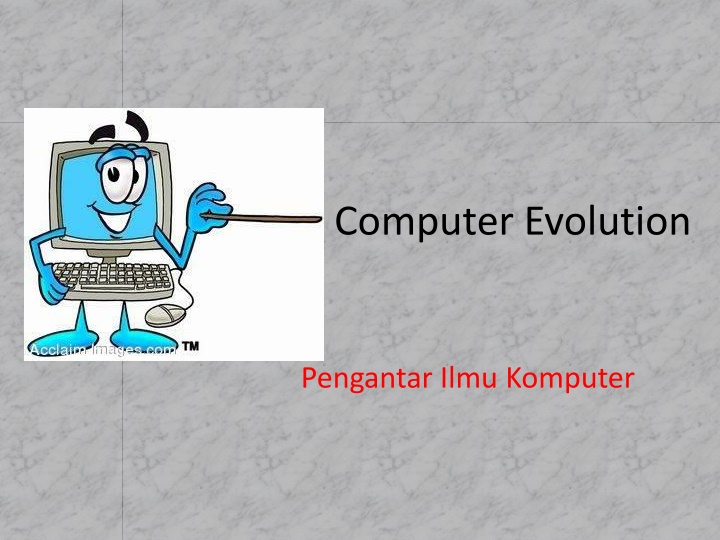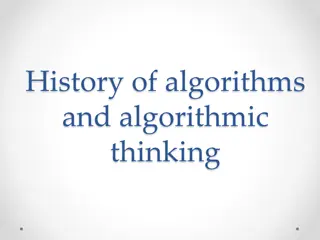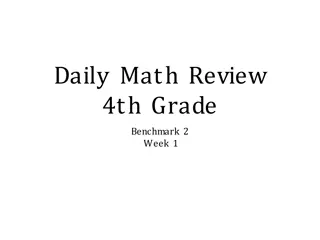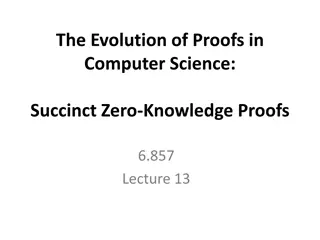
Evolution of Computing Devices: From Manual Tools to Electronic Machines
Explore the fascinating journey of computing devices from ancient manual tools like bones and abacus to modern electronic machines. Discover key milestones such as the invention of Pascal's calculating machine and the first analog computer. Witness the evolution of technology through the ages and its impact on society.
Download Presentation

Please find below an Image/Link to download the presentation.
The content on the website is provided AS IS for your information and personal use only. It may not be sold, licensed, or shared on other websites without obtaining consent from the author. If you encounter any issues during the download, it is possible that the publisher has removed the file from their server.
You are allowed to download the files provided on this website for personal or commercial use, subject to the condition that they are used lawfully. All files are the property of their respective owners.
The content on the website is provided AS IS for your information and personal use only. It may not be sold, licensed, or shared on other websites without obtaining consent from the author.
E N D
Presentation Transcript
Computer Evolution Pengantar Ilmu Komputer
Computer Classification Computer Processing Device Consist of 4 classification : Manual Device Mechanic Device Electronic Mechanic Device Electronic Device
Manual Device Bone (30000BC) Used for reminder and communication ex : to count distance Petroglyphs (30000 BC) Used for note data
Bones Lebombo Bone (35000 BC) Ishango Bone (20000 BC)
Mechanic Device First Counting Device (Wilhem Schickard)
Electronic Mechanic Device 1890 Tabulation Machine (created by Dr. Herman Hollerith) 1920 1stotomatic counter machine (decision maker machine, by Leonardo Torresy Quevedo,Spain) 1931 1stAnalog Computer (Differensial Analyzer, Dr. Vannevar Bush, MIT) 1938 1stelectronic mechanic device (Complex Calculator, George R. Stibitz, Bell Laboratories)
Electronic Device 1942 1stdigital computer 1944 Hardvard Mark I ASCC (1stotomatic arithmetic and logic, made by IBM, Prof. Howard Aiken,Harvard University )
1stGeneration (1946 1959) 1. Vacuum tube 2. Machine/Assembly Language 3. Secondary Storage : Magnetic Tape and Magnetic Disk 4. Punch Card and paper tape to feed program and to get results 5. Bulky 6. High Cost 7. Small Capacity 8. Consume more power with limited performance 9. Slow Process 10. For Scientific Computations
2ndGeneration (1959-1964) 1. Transistor 2. High Level Language : fortran, cobol 3. Magnetic ferrite core memories were used as main memory 4. Bigger memory capacity 5. Magnetic tapes and magnetic disks were used as secondary memory 6. Real time and Time sharing capabilities 7. Smaller in size 8. Punch cards used continued 9. Lesser power consumption and better performance 10. Busines application and Technique
3rdGeneration (1964 1970) 1. IC (Integrated Circuit) as main component 2. Better Software 3. 10000 times Faster then 1stgeneration 4. Bigger memory capacities 5. External Storage 6. Smaller electric power consumption 7. Multiprocessing and multiprogramming 8. Cheaper price 9. Smaller size 10.Visual and graphic display 11.Communication with other computer
4thGeneration (1970 - ) 1. Smaller size 2. Faster Processing 3. Cheaper Price 4. Bigger Capacity 5. Personal used 6. Software Development 7. Online application
5thGeneration Artificial Intelligent
Future Computer Biochip synthetic Protein Similar to human characteristic : has emotion and thinking
Computer Classification How to Process Data How to use Size Generation
Way to Process Data Analog Computer For continue data and physical form ex : electricity, temperature, speed, pressure use for hospital (heart pressure), oil pipe, electricity power advantage : accept physical data and measure data without conversion weakness : precision
Way to Process Data Digital Computer Numeric and character data form and usually used for business and technique Advantage : Faster data processing Data Storing Logical operation capabilities Correctional or erasable data Numeric, character and graphic output display
Way to Process Data Hybrid Computer Combination of analog computer and digital computer
Way to use Special Purpose Computer Made for certain case, usually used to handle one case. Used for automatic controller for industry. Ex : analog computer General Purpose Computer Made for handling many case. Slower then special purpose computer. Used for business, technique, education, word processing, gaming etc. Ex : General purpose computer
Size and Model Micro Computer Single user PC or notebook Small Space Smaller operand register Divide to 2 Types : Desktop Portable Laptop Notebook Palmtop Wearable Computer Mini Computer Multiuser Small room
Size Medium Computer Has many Input and Output Devices Used for Data Communication with hundreds terminal and separate from computer center Expensive Large Computer Large size Usually used by big company High speed processing and big capacity, timesharing capabilities Expensive
Size Super Computer Thousands Computer connected More effective in time sharing Very expensive






















